Abstract
Two isoforms of the human growth hormone receptor (hGHR), which differ in the presence (hGHRwt) or absence (hGHRd3) of exon 3, are expressed in the placenta. Specifically, three expression patterns are observed: only hGHRwt, only hGHRd3, or an approximately 1:1 combination of both isoforms. We investigated several potential regulatory mechanisms which might account for the expression of the hGHR isoforms. The frequency of hGHRd3 expression did not change when placentas from differing stages of gestation were examined, suggesting splicing was not developmentally regulated. However, when hGHR isoform expression patterns were examined in each component of a given placenta, it was evident that alternative splicing of exon 3 is individual-specific. Surprisingly, the individual-specific regulation of hGHR isoforms appears to be the result of a polymorphism in the hGHR gene. We analyzed hGHRwt and hGHRd3 expression in Hutterite pedigrees, and our results are consistent with a simple Mendelian inheritance of two differing alleles in which exon 3 is spliced in an "all-or-none" fashion. We conclude the alternative splicing of exon 3 in hGHR transcripts is the result of an unusual polymorphism which significantly alters splicing of the hGHR transcript and that the relatively high frequency (approximately 10%) of homozygous hGHRd3 expression suggests the possibility it may play a role in polygenic determined events.
Full text
PDF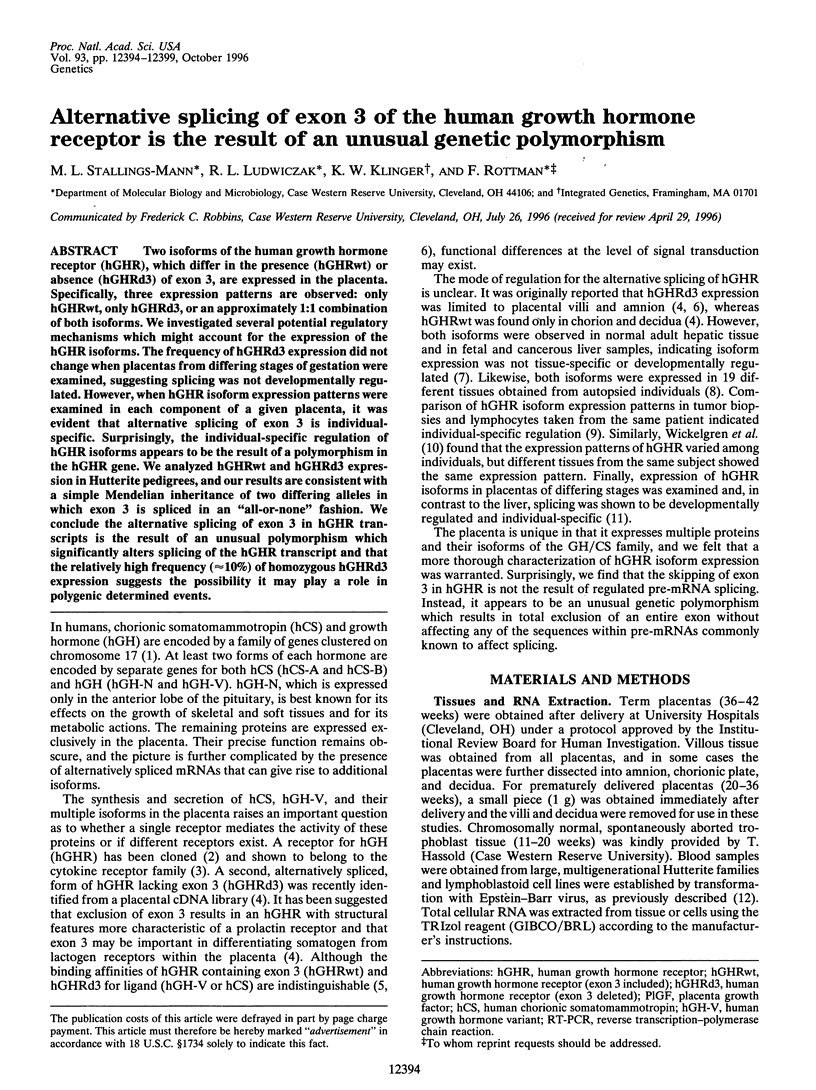
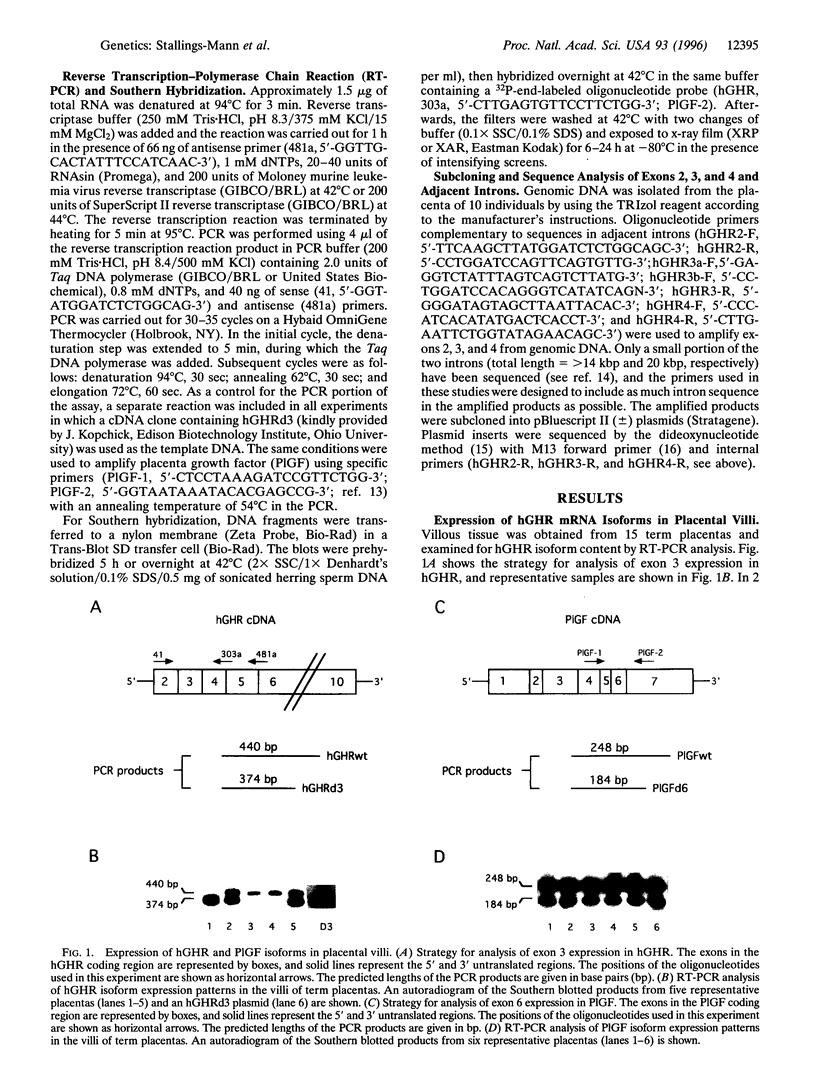
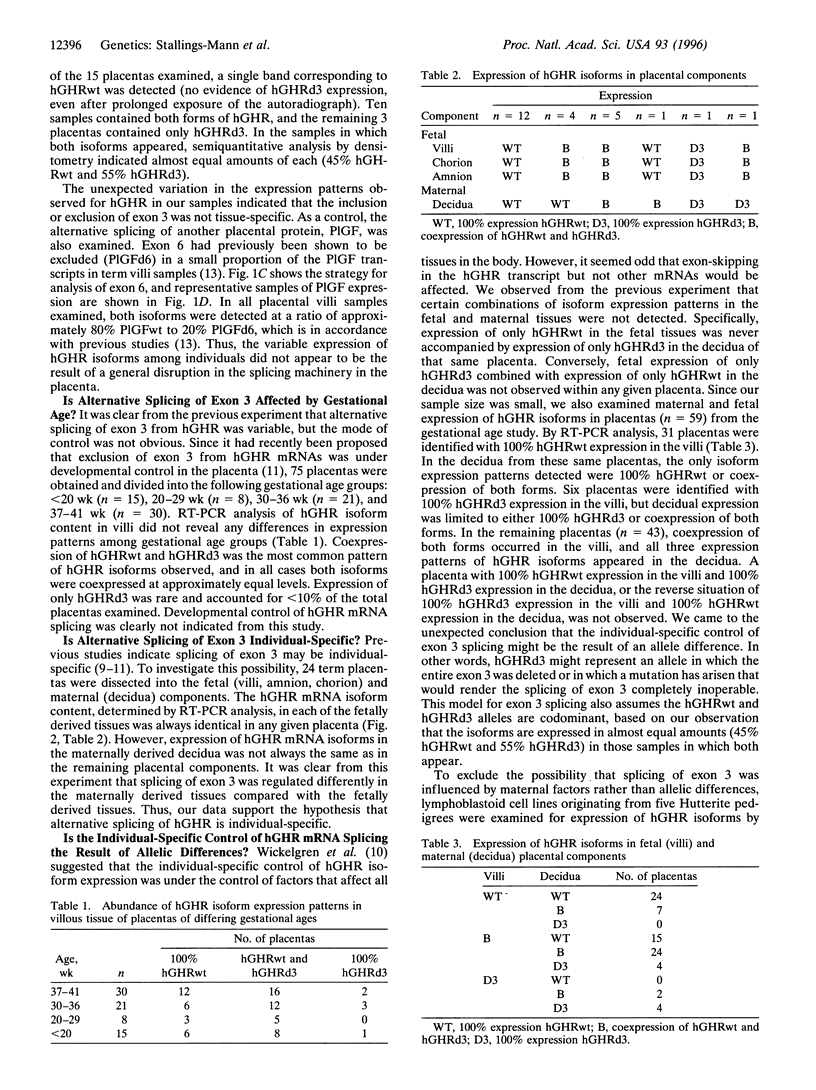
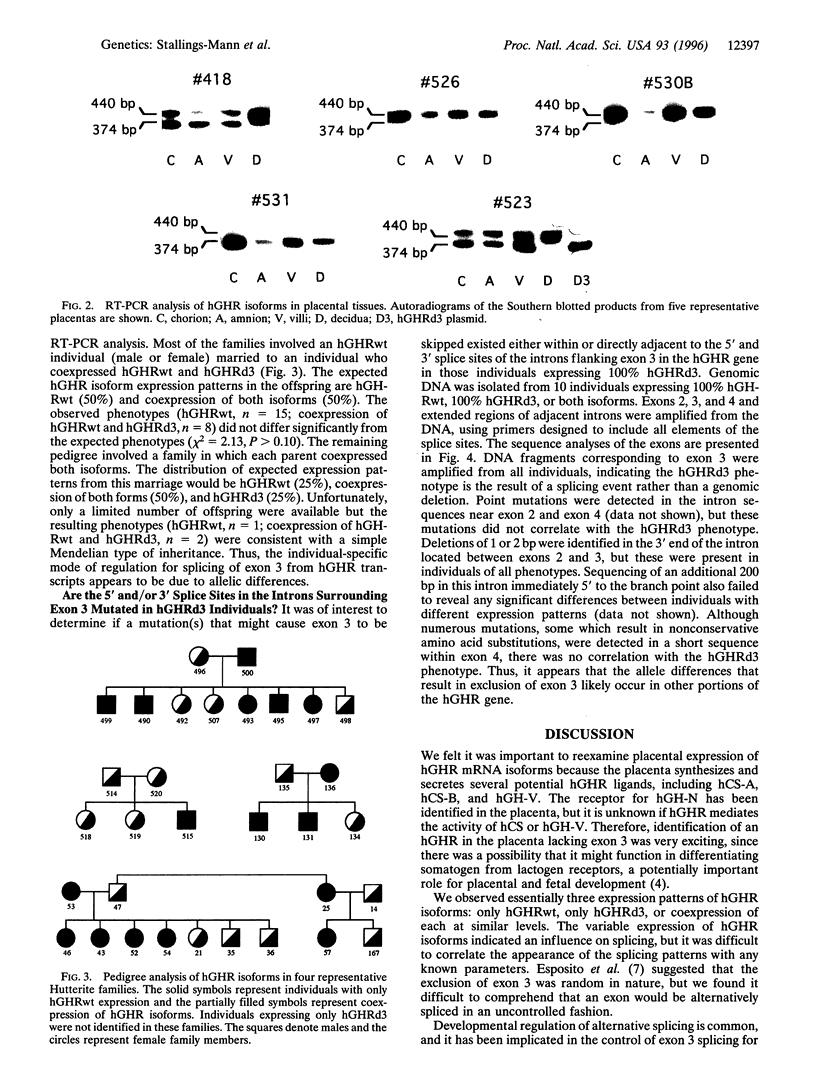
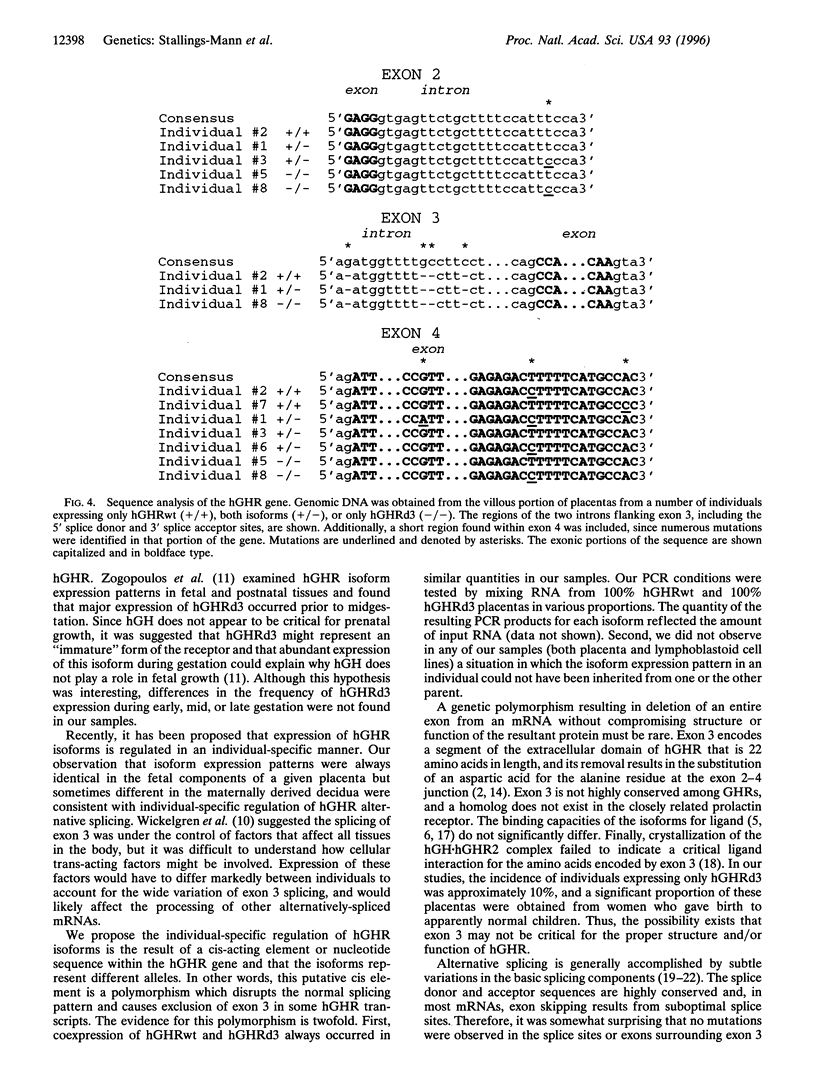
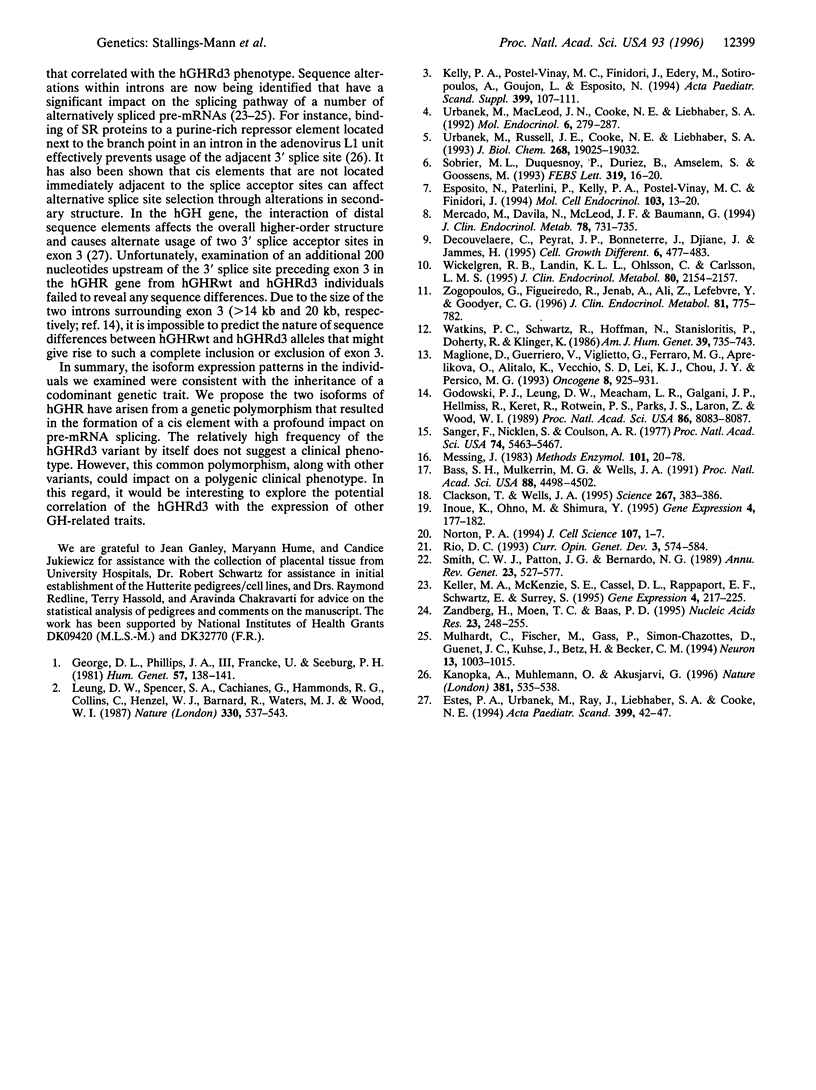
Images in this article
Selected References
These references are in PubMed. This may not be the complete list of references from this article.
- Bass S. H., Mulkerrin M. G., Wells J. A. A systematic mutational analysis of hormone-binding determinants in the human growth hormone receptor. Proc Natl Acad Sci U S A. 1991 May 15;88(10):4498–4502. doi: 10.1073/pnas.88.10.4498. [DOI] [PMC free article] [PubMed] [Google Scholar]
- Clackson T., Wells J. A. A hot spot of binding energy in a hormone-receptor interface. Science. 1995 Jan 20;267(5196):383–386. doi: 10.1126/science.7529940. [DOI] [PubMed] [Google Scholar]
- Decouvelaere C., Peyrat J. P., Bonneterre J., Djiane J., Jammes H. Presence of the two growth hormone receptor messenger RNA isoforms in human breast cancer. Cell Growth Differ. 1995 Apr;6(4):477–483. [PubMed] [Google Scholar]
- Esposito N., Paterlini P., Kelly P. A., Postel-Vinay M. C., Finidori J. Expression of two isoforms of the human growth hormone receptor in normal liver and hepatocarcinoma. Mol Cell Endocrinol. 1994 Jul;103(1-2):13–20. doi: 10.1016/0303-7207(94)90064-7. [DOI] [PubMed] [Google Scholar]
- Estes P. A., Urbanek M., Ray J., Liebhaber S. A., Cooke N. E. Alternative splice site selection in the human growth hormone gene transcript and synthesis of the 20 kDa isoform: role of higher order transcript structure. Acta Paediatr Suppl. 1994 Apr;399:42–48. doi: 10.1111/j.1651-2227.1994.tb13285.x. [DOI] [PubMed] [Google Scholar]
- George D. L., Phillips J. A., 3rd, Francke U., Seeburg P. H. The genes for growth hormone and chorionic somatomammotropin are on the long arm of human chromosome 17 in region q21 to qter. Hum Genet. 1981;57(2):138–141. doi: 10.1007/BF00282009. [DOI] [PubMed] [Google Scholar]
- Godowski P. J., Leung D. W., Meacham L. R., Galgani J. P., Hellmiss R., Keret R., Rotwein P. S., Parks J. S., Laron Z., Wood W. I. Characterization of the human growth hormone receptor gene and demonstration of a partial gene deletion in two patients with Laron-type dwarfism. Proc Natl Acad Sci U S A. 1989 Oct;86(20):8083–8087. doi: 10.1073/pnas.86.20.8083. [DOI] [PMC free article] [PubMed] [Google Scholar]
- Inoue K., Ohno M., Shimura Y. Aspects of splice site selection in constitutive and alternative pre-mRNA splicing. Gene Expr. 1995;4(3):177–182. [PMC free article] [PubMed] [Google Scholar]
- Kanopka A., Mühlemann O., Akusjärvi G. Inhibition by SR proteins of splicing of a regulated adenovirus pre-mRNA. Nature. 1996 Jun 6;381(6582):535–538. doi: 10.1038/381535a0. [DOI] [PubMed] [Google Scholar]
- Keller M. A., McKenzie S. E., Cassel D. L., Rappaport E. F., Schwartz E., Surrey S. Lineage-specific alternative splicing of the human Fc gamma RIIA transmembrane exon requires sequences near the 3' splice site. Gene Expr. 1995;4(4-5):217–225. [PMC free article] [PubMed] [Google Scholar]
- Kelly P. A., Postel-Vinay M. C., Finidori J., Edery M., Sotiropoulos A., Goujon L., Esposito N. Growth hormone receptor structure, dimerization and function. Acta Paediatr Suppl. 1994 Apr;399:107–111. doi: 10.1111/j.1651-2227.1994.tb13301.x. [DOI] [PubMed] [Google Scholar]
- Leung D. W., Spencer S. A., Cachianes G., Hammonds R. G., Collins C., Henzel W. J., Barnard R., Waters M. J., Wood W. I. Growth hormone receptor and serum binding protein: purification, cloning and expression. Nature. 1987 Dec 10;330(6148):537–543. doi: 10.1038/330537a0. [DOI] [PubMed] [Google Scholar]
- Maglione D., Guerriero V., Viglietto G., Ferraro M. G., Aprelikova O., Alitalo K., Del Vecchio S., Lei K. J., Chou J. Y., Persico M. G. Two alternative mRNAs coding for the angiogenic factor, placenta growth factor (PlGF), are transcribed from a single gene of chromosome 14. Oncogene. 1993 Apr;8(4):925–931. [PubMed] [Google Scholar]
- Mercado M., DáVila N., McLeod J. F., Baumann G. Distribution of growth hormone receptor messenger ribonucleic acid containing and lacking exon 3 in human tissues. J Clin Endocrinol Metab. 1994 Mar;78(3):731–735. doi: 10.1210/jcem.78.3.8126150. [DOI] [PubMed] [Google Scholar]
- Messing J. New M13 vectors for cloning. Methods Enzymol. 1983;101:20–78. doi: 10.1016/0076-6879(83)01005-8. [DOI] [PubMed] [Google Scholar]
- Mülhardt C., Fischer M., Gass P., Simon-Chazottes D., Guénet J. L., Kuhse J., Betz H., Becker C. M. The spastic mouse: aberrant splicing of glycine receptor beta subunit mRNA caused by intronic insertion of L1 element. Neuron. 1994 Oct;13(4):1003–1015. doi: 10.1016/0896-6273(94)90265-8. [DOI] [PubMed] [Google Scholar]
- Norton P. A. Alternative pre-mRNA splicing: factors involved in splice site selection. J Cell Sci. 1994 Jan;107(Pt 1):1–7. doi: 10.1242/jcs.107.1.1. [DOI] [PubMed] [Google Scholar]
- Rio D. C. Splicing of pre-mRNA: mechanism, regulation and role in development. Curr Opin Genet Dev. 1993 Aug;3(4):574–584. doi: 10.1016/0959-437x(93)90093-5. [DOI] [PubMed] [Google Scholar]
- Sanger F., Nicklen S., Coulson A. R. DNA sequencing with chain-terminating inhibitors. Proc Natl Acad Sci U S A. 1977 Dec;74(12):5463–5467. doi: 10.1073/pnas.74.12.5463. [DOI] [PMC free article] [PubMed] [Google Scholar]
- Smith C. W., Patton J. G., Nadal-Ginard B. Alternative splicing in the control of gene expression. Annu Rev Genet. 1989;23:527–577. doi: 10.1146/annurev.ge.23.120189.002523. [DOI] [PubMed] [Google Scholar]
- Sobrier M. L., Duquesnoy P., Duriez B., Amselem S., Goossens M. Expression and binding properties of two isoforms of the human growth hormone receptor. FEBS Lett. 1993 Mar 15;319(1-2):16–20. doi: 10.1016/0014-5793(93)80028-s. [DOI] [PubMed] [Google Scholar]
- Urbanek M., MacLeod J. N., Cooke N. E., Liebhaber S. A. Expression of a human growth hormone (hGH) receptor isoform is predicted by tissue-specific alternative splicing of exon 3 of the hGH receptor gene transcript. Mol Endocrinol. 1992 Feb;6(2):279–287. doi: 10.1210/mend.6.2.1569971. [DOI] [PubMed] [Google Scholar]
- Urbanek M., Russell J. E., Cooke N. E., Liebhaber S. A. Functional characterization of the alternatively spliced, placental human growth hormone receptor. J Biol Chem. 1993 Sep 5;268(25):19025–19032. [PubMed] [Google Scholar]
- Watkins P. C., Schwartz R., Hoffman N., Stanislovitis P., Doherty R., Klinger K. A linkage study of cystic fibrosis in extended multigenerational pedigrees. Am J Hum Genet. 1986 Dec;39(6):735–743. [PMC free article] [PubMed] [Google Scholar]
- Wickelgren R. B., Landin K. L., Ohlsson C., Carlsson L. M. Expression of exon 3-retaining and exon 3-excluding isoforms of the human growth hormone-receptor is regulated in an interindividual, rather than a tissue-specific, manner. J Clin Endocrinol Metab. 1995 Jul;80(7):2154–2157. doi: 10.1210/jcem.80.7.7608270. [DOI] [PubMed] [Google Scholar]
- Zandberg H., Moen T. C., Baas P. D. Cooperation of 5' and 3' processing sites as well as intron and exon sequences in calcitonin exon recognition. Nucleic Acids Res. 1995 Jan 25;23(2):248–255. [PMC free article] [PubMed] [Google Scholar]
- Zogopoulos G., Figueiredo R., Jenab A., Ali Z., Lefèbvre Y., Goodyer C. G. Expression of exon 3-retaining and -deleted human growth hormone receptor messenger ribonucleic acid isoforms during development. J Clin Endocrinol Metab. 1996 Feb;81(2):775–782. doi: 10.1210/jcem.81.2.8636303. [DOI] [PubMed] [Google Scholar]




